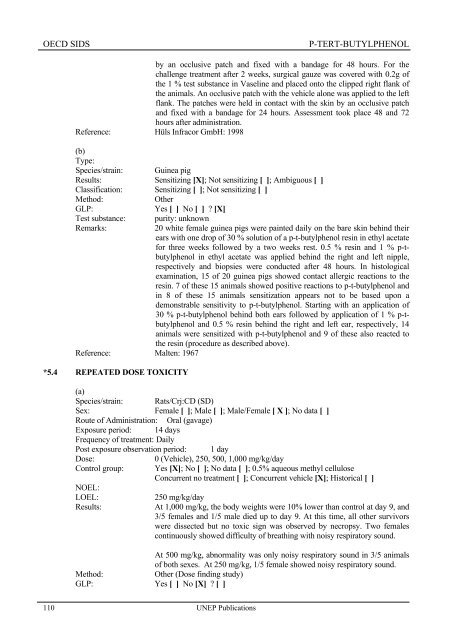p-Tert-Butylphenol - UNEP Chemicals
p-Tert-Butylphenol - UNEP Chemicals
p-Tert-Butylphenol - UNEP Chemicals
You also want an ePaper? Increase the reach of your titles
YUMPU automatically turns print PDFs into web optimized ePapers that Google loves.
OECD SIDS P-TERT-BUTYLPHENOL<br />
110<br />
by an occlusive patch and fixed with a bandage for 48 hours. For the<br />
challenge treatment after 2 weeks, surgical gauze was covered with 0.2g of<br />
the 1 % test substance in Vaseline and placed onto the clipped right flank of<br />
the animals. An occlusive patch with the vehicle alone was applied to the left<br />
flank. The patches were held in contact with the skin by an occlusive patch<br />
and fixed with a bandage for 24 hours. Assessment took place 48 and 72<br />
hours after administration.<br />
Reference: Hüls Infracor GmbH: 1998<br />
(b)<br />
Type:<br />
Species/strain: Guinea pig<br />
Results: Sensitizing [X]; Not sensitizing [ ]; Ambiguous [ ]<br />
Classification: Sensitizing [ ]; Not sensitizing [ ]<br />
Method: Other<br />
GLP: Yes [ ] No [ ] ? [X]<br />
Test substance: purity: unknown<br />
Remarks: 20 white female guinea pigs were painted daily on the bare skin behind their<br />
ears with one drop of 30 % solution of a p-t-butylphenol resin in ethyl acetate<br />
for three weeks followed by a two weeks rest. 0.5 % resin and 1 % p-tbutylphenol<br />
in ethyl acetate was applied behind the right and left nipple,<br />
respectively and biopsies were conducted after 48 hours. In histological<br />
examination, 15 of 20 guinea pigs showed contact allergic reactions to the<br />
resin. 7 of these 15 animals showed positive reactions to p-t-butylphenol and<br />
in 8 of these 15 animals sensitization appears not to be based upon a<br />
demonstrable sensitivity to p-t-butylphenol. Starting with an application of<br />
30 % p-t-butylphenol behind both ears followed by application of 1 % p-tbutylphenol<br />
and 0.5 % resin behind the right and left ear, respectively, 14<br />
animals were sensitized with p-t-butylphenol and 9 of these also reacted to<br />
the resin (procedure as described above).<br />
Reference: Malten: 1967<br />
*5.4 REPEATED DOSE TOXICITY<br />
(a)<br />
Species/strain: Rats/Crj:CD (SD)<br />
Sex: Female [ ]; Male [ ]; Male/Female [ X ]; No data [ ]<br />
Route of Administration: Oral (gavage)<br />
Exposure period: 14 days<br />
Frequency of treatment: Daily<br />
Post exposure observation period: 1 day<br />
Dose: 0 (Vehicle), 250, 500, 1,000 mg/kg/day<br />
Control group: Yes [X]; No [ ]; No data [ ]; 0.5% aqueous methyl cellulose<br />
Concurrent no treatment [ ]; Concurrent vehicle [X]; Historical [ ]<br />
NOEL:<br />
LOEL: 250 mg/kg/day<br />
Results: At 1,000 mg/kg, the body weights were 10% lower than control at day 9, and<br />
3/5 females and 1/5 male died up to day 9. At this time, all other survivors<br />
were dissected but no toxic sign was observed by necropsy. Two females<br />
continuously showed difficulty of breathing with noisy respiratory sound.<br />
At 500 mg/kg, abnormality was only noisy respiratory sound in 3/5 animals<br />
of both sexes. At 250 mg/kg, 1/5 female showed noisy respiratory sound.<br />
Method: Other (Dose finding study)<br />
GLP: Yes [ ] No [X] ? [ ]<br />
<strong>UNEP</strong> Publications
















